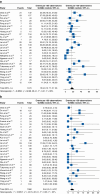Oncological, surgical, and cosmetic outcomes of endoscopic versus conventional nipple-sparing mastectomy: meta-analysis
- PMID: 40392529
- PMCID: PMC12090896
- DOI: 10.1093/bjsopen/zraf011
Oncological, surgical, and cosmetic outcomes of endoscopic versus conventional nipple-sparing mastectomy: meta-analysis
Abstract
Background: Endoscopic nipple-sparing mastectomy has been developed to improve the cosmetic outcomes of conventional nipple-sparing mastectomy. This meta-analysis compares surgical, quality of life and oncological outcomes of endoscopic nipple-sparing mastectomy versus conventional nipple-sparing mastectomy.
Methods: PubMed and Embase were systematically reviewed to identify literature relevant to endoscopic nipple-sparing mastectomy and conventional nipple-sparing mastectomy literature published through to August 2023. The risk of bias was assessed using the Newcastle-Ottawa Scale, and proportional and pairwise random-effects meta-analysis was performed. Surgical (operative time, duration of hospital stay, blood loss, necrosis, overall complications), quality of life (cosmesis, pain, nipple-areolar complex sensitivity) and oncological outcomes (margin positivity, recurrence, metastasis and breast cancer-specific mortality rate) were evaluated.
Results: Of 1286 articles retrieved, 51 endoscopic nipple-sparing mastectomy studies and 12 conventional nipple-sparing mastectomy reviews were analysed; 10 non-randomized comparative studies (656 patients) were included in the pairwise analysis and 36 studies (comparative and single-group cohort studies; 2612 patients) in the proportional meta-analysis. Results showed no differences in oncological outcomes (mean follow-up of up to 52 months), comparable overall (OR = 0.49; P = 0.100) and necrotic complications (OR = 0.45; P = 0.150), and improved cosmetic satisfaction (OR = 1.88; P = 0.020). Comparing only single-incision endoscopic nipple-sparing mastectomy to conventional nipple-sparing mastectomy significantly reduced postoperative necrosis (OR = 0.19; P = 0.008). The proportional meta-analysis produced oncological and surgical outcome rates comparable to or lower than conventional nipple-sparing mastectomy rates. However, longer operative time (weighted mean difference = 43.08 min; P < 0.00001) and duration of hospital stay (weighted mean difference = 0.72 days; P = 0.0007) were observed.
Conclusion: Endoscopic nipple-sparing mastectomy does not affect oncological outcomes in up to 52 months mean follow-up when compared with conventional nipple-sparing mastectomy and provides better cosmetic satisfaction, with a reduced risk of necrosis after single-incision endoscopic nipple-sparing mastectomy. As such, endoscopic nipple-sparing mastectomy may become a viable breast surgery option.
© The Author(s) 2025. Published by Oxford University Press on behalf of BJS Foundation Ltd.
Figures








References
-
- Breast Cancer Facts and Statistics . 2024. https://www.breastcancer.org/facts-statistics (accessed 1 February 2024)
-
- Sedeta ET, Jobre B, Avezbakiyev B. Breast cancer: global patterns of incidence, mortality, and trends. J Clin Oncol 2023;41:10528
-
- Endara M, Chen D, Verma K, Nahabedian MY, Spear SL. Breast reconstruction following nipple-sparing mastectomy: a systematic review of the literature with pooled analysis. Plast Reconstr Surg 2013;132:1043–1054 - PubMed
-
- Lai HW, Chen ST, Liao CY, Mok CW, Lin YJ, Chen DR et al. Oncologic outcome of endoscopic assisted breast surgery compared with conventional approach in breast cancer: an analysis of 3426 primary operable breast cancer patients from single institute with and without propensity score matching. Ann Surg Oncol 2021;28:7368–7380 - PubMed
Publication types
MeSH terms
Grants and funding
LinkOut - more resources
Full Text Sources
Medical
Research Materials

